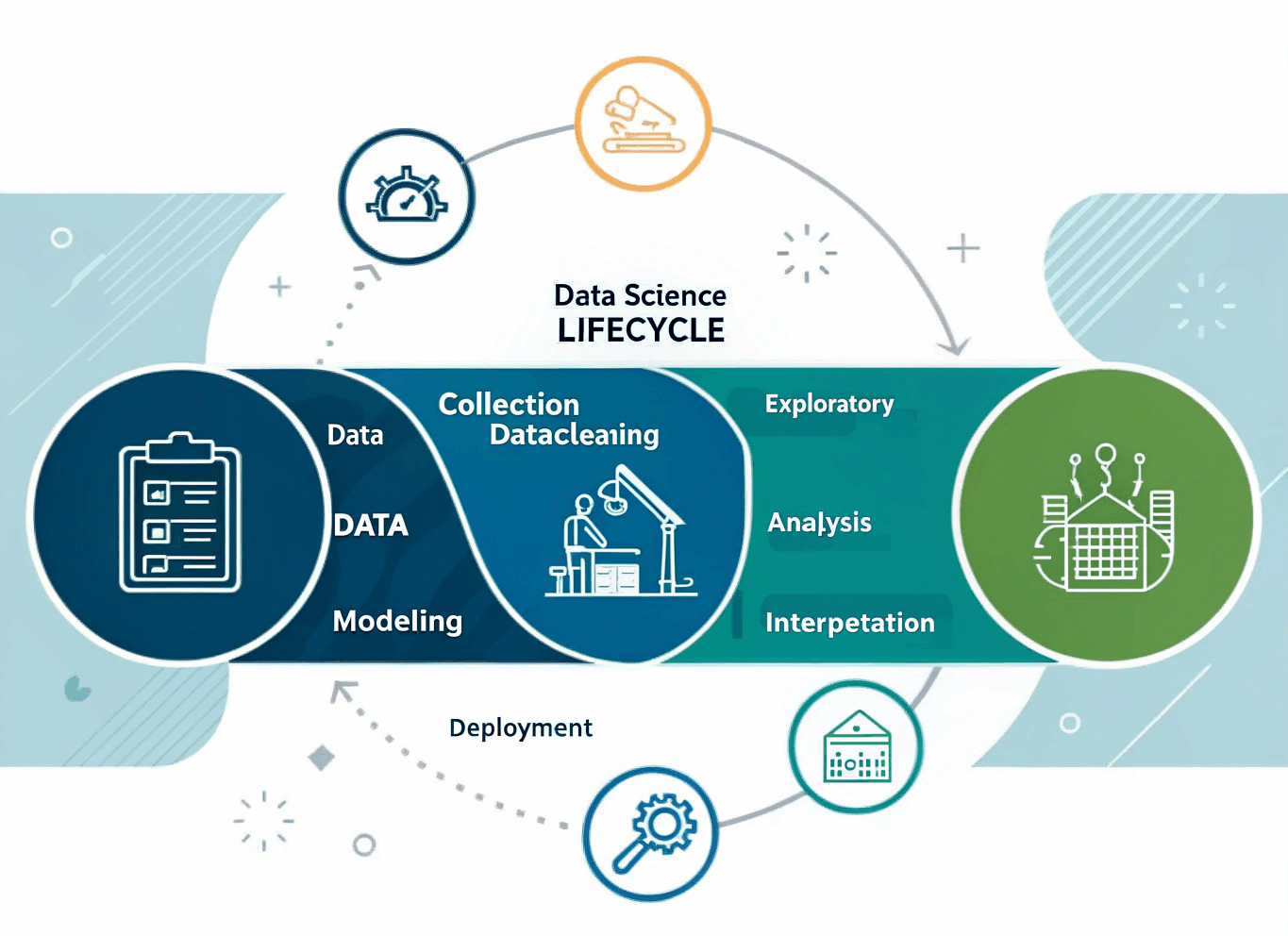
Course 1: Introduction to Data Science
Curriculum
- 9 Sections
- 168 Lessons
- 26 Quizzes
- 18 Assignments
- 0m Duration
Section 1: The Data Science Lifecycle
17 Lessons3 Quizzes
- Module 1.1: What Is Data Science? Definitions & Scope
- 1.1.1 Definition and Core Components
- 1.1.2 Distinction from Related Fields
- 1.1.3 The Data Science Workflow
- 1.1.4 Real-World Applications
- 1.1 Quiz
- Module 1.2: Stages of a Data Science Project
- 1.2.1 Stage 1: Problem Definition
- 1.2.2 Stage 2: Data Acquisition
- 1.2.3 Stage 3: Data Cleaning & Preparation
- 1.2.4 Stage 4: Exploratory Data Analysis (EDA)
- 1.2.5 Stage 5: Modeling
- 1.2.6 Stage 6: Interpretation & Communication
- 1.2.7 Stage 7: Deployment & Monitoring
- 1.2 Quiz
- Module 1.3: Roles & Responsibilities in Data Science Teams
- 1.3.1 Key Roles
- 1.3.2 Collaboration Across Stages
- 1.3.3 Skills Matrix & Growth Path
- 1.3 Quiz
Section 2: Tools & Environments
21 Lessons3 Quizzes
- Module 2.1: Python Ecosystem Overview (NumPy, pandas, Matplotlib)
- 2.1.1 Why Python for Data Science?
- 2.1.2 NumPy: Numerical Computing Foundation
- 2.1.3 pandas: Tabular Data Manipulation
- 2.1.4 Matplotlib: Basic Visualization
- 2.1.5 Best Practices & Tips
- 2.1.6 Hands-On Assignment 2.1
- 2.1 Quiz
- Module 2.2: Jupyter Notebooks & VS Code Setup
- 2.2.1 Installing Jupyter bash Copy Edit
- 2.2.2 Launching & Navigating bash Copy Edit
- 2.2.3 VS Code Setup
- 2.2.4 Notebooks vs. Scripts
- 2.2.5 Best Practices
- 2.2.6 Hands-On Assignment 2.2
- 2.2 Quiz
- Module 2.3: Version Control with Git & GitHub
- 2.3.1 Git Basics
- 2.3.2 Core Git Workflow
- 2.3.3 Branching & Merging
- 2.3.4 Remote Repositories & GitHub
- 2.3.5 Collaboration Best Practices
- 2.3.6 Hands-On Assignment 2.3
- 2.3 Quiz
Section 3: Data Exploration & Visualization
25 Lessons3 Quizzes
- Module 3.1: Exploratory Data Analysis (EDA) Principles
- 3.1.1 Purpose of EDA
- 3.1.2 Statistical Summaries
- 3.1.3 Univariate Analysis
- 3.1.4 Bivariate Analysis
- 3.1.5 Multivariate Analysis
- 3.1.6 EDA Workflow Best Practices
- 3.1.7 Hands-On Assignment 3.1
- 3.1 Quiz
- Module 3.2: Descriptive Statistics & Basic Plots
- 3.2.1 Descriptive Statistics Refresher
- 3.2.2 Histogram
- 3.2.3 Bar Chart
- 3.2.4 Box Plot
- 3.2.5 Line Chart
- 3.2.6 Choosing the Right Plot
- 3.2.7 Hands-On Assignment 3.2
- 3.2 Quiz
- Module 3.3: Case Study – EDA on Sample Dataset
- 3.3.1 Dataset Overview
- 3.3.2 Step 1: Data Loading & Initial Inspection python Copy Edit
- 3.3.3 Step 2: Data Cleaning
- 3.3.4 Step 3: Univariate Analysis
- 3.3.5 Step 4: Bivariate Analysis
- 3.3.6 Step 5: Correlation Analysis python Copy Edit
- 3.3.7 Step 6: Summary of Findings
- 3.3.8 Hands-On Assignment 3.3
- 3.3 Quiz
Section 4: Data Ethics & Reproducibility
18 Lessons3 Quizzes3 Assignments
- Module 4.1: Data Ethics, Privacy & Reproducibility
- 4.1.1 Ethical Principles in Data Science
- 4.1.2 Sources of Bias & Mitigation
- 4.1.3 Data Privacy & Protection
- 4.1.4 Reproducible Workflows
- 4.1.5 Documentation & Collaboration
- Hands-On Assignment 4.1
- 4.1 Quiz
- Module 4.2: Documentation & Reproducible Pipelines
- 4.2.1 Project Documentation Essentials
- 4.2.2 Workflow Automation with Makefiles
- 4.2.3 Orchestrating with Prefect (or Airflow)
- 4.2.4 Data Versioning with DVC
- 4.2.5 Best Practices for Reproducibility
- Hands-On Assignment 4.2
- 4.2 Quiz
- Module 4.3: Collaboration Best Practices & Versioning
- 4.3.1 Branching Strategies
- 4.3.2 Pull Requests & Code Review
- 4.3.3 Issues & Project Boards
- 4.3.4 Collaborative Communication
- 4.3.5 CI/CD Integration
- Hands-On Assignment 4.3
- 4.3 Quiz
Section 5: Modeling
19 Lessons2 Quizzes3 Assignments
- Module 5.1: Supervised Learning Algorithms
- 5.1.1 What Is Supervised Learning?
- 5.1.2 Common Regression Algorithms
- 5.1.3 Common Classification Algorithms
- 5.1.4 Workflow: Train–Test Split & Evaluation
- 5.1.5 Bias–Variance Trade-off
- 5.1.6 Hands-On Assignment 5.1
- 5.1 Quiz
- Module 5.2: Model Selection & Hyperparameter Tuning
- 5.2.1 The Need for Model Selection
- 5.2.2 Cross-Validation Techniques
- 5.2.3 Hyperparameter Tuning Strategies
- 5.2.4 Avoiding Data Leakage
- 5.2.5 Interpreting Tuning Results
- 5.2.6 Hands-On Assignment 5.2
- 5.2 Quiz
- Module 5.3: Bias–Variance Trade-off & Regularization
- 5.3.1 Understanding Bias and Variance
- 5.3.2 Visualizing the Trade-off
- 5.3.3 Regularization Techniques
- 5.3.4 Choosing Regularization Strength
- 5.3.5 When to Use L1 vs. L2
- 5.3.6 Hands-On Assignment 5.3
- 5.3 Quiz
Section 6: Deep Learning Specialization
21 Lessons3 Quizzes3 Assignments
- Module 6.1: Neural Networks & Deep Learning Basics
- 6.1.1 Neural Network Architecture
- 6.1.2 Activation Functions
- 6.1.3 Forward & Backward Propagation
- 6.1.4 Implementing a Simple Network (TensorFlow) python Copy Edit
- 6.1.5 Key Hyperparameters
- 6.1.6 Hands-On Assignment 6.1
- 6.1 Quiz
- Module 6.2: Convolutional Neural Networks (CNNs)
- 6.2.1 Convolutional Layers
- 6.2.2 Activation & Nonlinearity
- 6.2.3 Pooling Layers
- 6.2.4 Classic CNN Architectures
- 6.2.5 Building a Simple CNN (Keras) python Copy Edit
- 6.2.6 Tips & Best Practices
- Hands-On Assignment 6.2
- 6.2 Quiz
- Module 6.3: Recurrent Neural Networks (RNNs) & Transformers
- 6.3.1 Recurrent Neural Networks (RNNs)
- 6.3.2 LSTM & GRU Cells
- 6.3.3 Sequence Modeling Tasks
- 6.3.4 Implementing an RNN for Text Classification python Copy Edit
- 6.3.5 Transformer & Self-Attention
- 6.3.6 Building a Simple Transformer Classifier python Copy Edit
- 6.3.7 Comparison: RNN vs. Transformer
- Hands-On Assignment 6.3
- 6.3 Quiz
Section 7: Natural Language Processing (NLP)
17 Lessons3 Quizzes3 Assignments
- Module 7.1: NLP Fundamentals & Text Preprocessing
- 7.1.1 What Is NLP?
- 7.1.2 The NLP Pipeline
- 7.1.3 Text Preprocessing Steps
- 7.1.4 Feature Extraction: Bag-of-Words & TF-IDF
- 7.1.5 Choosing Preprocessing & Features
- Hands-On Assignment 7.1
- 7.1 Quiz
- Module 7.2: Text Classification with Naïve Bayes & Logistic Regression
- 7.2.1 Problem Setup: Text Classification
- 7.2.2 Multinomial Naïve Bayes
- 7.2.3 Logistic Regression for Text
- 7.2.4 Model Comparison
- 7.2.5 Hands-On Assignment 7.2
- 7.2 Quiz
- Module 7.3: Word Embeddings & Text Generation with RNNs/Transformers
- 7.3.1 Word Embeddings: Motivation & Methods
- 7.3.2 Training an Embedding Layer in Keras python Copy Edit
- 7.3.3 Using Pretrained Embeddings python Copy Edit
- 7.3.4 Text Generation with LSTM python Copy Edit
- 7.3.5 Text Generation with a Transformer python Copy Edit
- Hands-On Assignment 7.3
- 7.3 Quiz
Section 8: Applied AI Use-Cases
12 Lessons2 Quizzes2 Assignments
- Module 8.1: Computer Vision Applications
- 8.1.1 Core Vision Tasks
- 8.1.2 Pretrained Backbone for Classification python Copy Edit
- 8.1.3 Object Detection Overview
- 8.1.4 Semantic Segmentation Snapshot
- 8.1.5 Evaluation Metrics
- 8.1.6 Hands-On Assignment 8.1
- 8.1 Quiz
- Module 8.2: Deploying Models with MLOps & APIs
- 8.2.1 MLOps Lifecycle Overview
- 8.2.2 Containerizing with Docker
- 8.2.3 Building a FastAPI Prediction Service python Copy Edit
- 8.2.4 Orchestrating with Kubernetes (Optional)
- 8.2.5 Monitoring & Logging
- Hands-On Assignment 8.2
- 8.2 Quiz
Section 9: Capstone Project Kickoff & Data Challenge
18 Lessons4 Quizzes4 Assignments
- Module 9.1: Capstone Project Kickoff & Data Challenge
- 9.1.1 Capstone Overview
- 9.1.2 Data Challenge Description
- 9.1.3 Project Plan & Milestones
- 9.1.4 Roles & Collaboration (Team Option)
- 9.1.5 Hands-On Assignment 9.1
- 9.1 Quiz
- Module 9.2: Project Development & Interim Report
- 9.2.1 Data Ingestion & Cleaning Pipeline
- 9.2.2 Baseline Modeling
- 9.2.3 Interim Report Structure
- 9.2.4 Hands-On Assignment 9.2
- 9.2 Quiz
- Module 9.3: Model Refinement, Tuning & Advanced Techniques
- 9.3.1 Feature Engineering Enhancements
- 9.3.2 Advanced Algorithms
- 9.3.3 Hyperparameter Tuning Revisited
- 9.3.4 Evaluation of Refined Models
- Hands-On Assignment 9.3
- 9.3 Quiz
- Module 9.4: Final Presentation & Submission
- 9.4.1 Final Presentation Structure
- 9.4.2 Submission Checklist
- 9.4.3 Best Practices for Delivery
- Hands-On Assignment 9.4
- 9.4 Quiz
